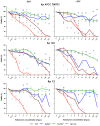Interplay among Different Fosfomycin Resistance Mechanisms in Klebsiella pneumoniae
- PMID: 33361305
- PMCID: PMC8092493
- DOI: 10.1128/AAC.01911-20
Interplay among Different Fosfomycin Resistance Mechanisms in Klebsiella pneumoniae
Abstract
The objectives of this study were to characterize the role of the uhpT, glpT, and fosA genes in fosfomycin resistance in Klebsiella pneumoniae and evaluate the use of sodium phosphonoformate (PPF) in combination with fosfomycin. Seven clinical isolates of K. pneumoniae and the reference strain (ATCC 700721) were used, and their genomes were sequenced. ΔuhpT, ΔglpT, and ΔfosA mutants were constructed from two isolates and K. pneumoniae ATCC 700721. Fosfomycin susceptibility testing was done by the gradient strip method. Synergy between fosfomycin and PPF was studied by checkerboard assay and analyzed using SynergyFinder. Spontaneous fosfomycin mutant frequencies at 64 and 512 mg/liter, in vitro activity using growth curves with fosfomycin gradient concentrations (0 to 256mg/liter), and time-kill assays at 64 and 307 mg/liter were evaluated with and without PPF (0.623 mM). The MICs of fosfomycin against the clinical isolates ranged from 16 to ≥1,024 mg/liter. The addition of 0.623 mM PPF reduced fosfomycin MIC between 2- and 8-fold. Deletion of fosA led to a 32-fold decrease. Synergistic activities were observed with the combination of fosfomycin and PPF (most synergistic area at 0.623 mM). The lowest fosfomycin-resistant mutant frequencies were found in ΔfosA mutants, with decreases in frequency from 1.69 × 10-1 to 1.60 × 10-5 for 64 mg/liter of fosfomycin. In the final growth monitoring and time-kill assays, fosfomycin showed a bactericidal effect only with the deletion of fosA and not with the addition of PPF. We conclude that fosA gene inactivation leads to a decrease in fosfomycin resistance in K. pneumoniae The pharmacological approach using PPF did not achieve enough activity, and the effect decreased with the presence of fosfomycin-resistant mutations.
Keywords: Klebsiella pneumoniae; antimicrobial resistance; fosfomycin.
Copyright © 2021 American Society for Microbiology.
Figures



Similar articles
-
Inhibition of Fosfomycin Resistance Protein FosA by Phosphonoformate (Foscarnet) in Multidrug-Resistant Gram-Negative Pathogens.Antimicrob Agents Chemother. 2017 Nov 22;61(12):e01424-17. doi: 10.1128/AAC.01424-17. Print 2017 Dec. Antimicrob Agents Chemother. 2017. PMID: 28993329 Free PMC article.
-
The Role of fosA in Challenges with Fosfomycin Susceptibility Testing of Multispecies Klebsiella pneumoniae Carbapenemase-Producing Clinical Isolates.J Clin Microbiol. 2019 Sep 24;57(10):e00634-19. doi: 10.1128/JCM.00634-19. Print 2019 Oct. J Clin Microbiol. 2019. PMID: 31340992 Free PMC article.
-
Glutathione-S-transferase FosA6 of Klebsiella pneumoniae origin conferring fosfomycin resistance in ESBL-producing Escherichia coli.J Antimicrob Chemother. 2016 Sep;71(9):2460-5. doi: 10.1093/jac/dkw177. Epub 2016 Jun 3. J Antimicrob Chemother. 2016. PMID: 27261267 Free PMC article.
-
In Vitro Pharmacodynamics of Fosfomycin against Carbapenem-Resistant Enterobacter cloacae and Klebsiella aerogenes.Antimicrob Agents Chemother. 2020 Aug 20;64(9):e00536-20. doi: 10.1128/AAC.00536-20. Print 2020 Aug 20. Antimicrob Agents Chemother. 2020. PMID: 32571821 Free PMC article.
-
Fosfomycin resistance mechanisms in Enterobacterales: an increasing threat.Front Cell Infect Microbiol. 2023 Jul 4;13:1178547. doi: 10.3389/fcimb.2023.1178547. eCollection 2023. Front Cell Infect Microbiol. 2023. PMID: 37469601 Free PMC article. Review.
Cited by
-
Clinical and Microbiological Risk Factors for 30-Day Mortality of Bloodstream Infections Caused by OXA-48-Producing Klebsiella pneumoniae.Pathogens. 2023 Dec 21;13(1):11. doi: 10.3390/pathogens13010011. Pathogens. 2023. PMID: 38276157 Free PMC article.
-
Molecular typing methods & resistance mechanisms of MDR Klebsiella pneumoniae.AIMS Microbiol. 2023 Feb 27;9(1):112-130. doi: 10.3934/microbiol.2023008. eCollection 2023. AIMS Microbiol. 2023. PMID: 36891535 Free PMC article. Review.
-
Emergence of KPC-8-producing K. pneumoniae infection without prior exposure to ceftazidime/avibactam: the threat of de novo infections by ceftazidime/avibactam-resistant KPC variants.Antimicrob Agents Chemother. 2025 Jun 4;69(6):e0149424. doi: 10.1128/aac.01494-24. Epub 2025 Apr 22. Antimicrob Agents Chemother. 2025. PMID: 40261073 Free PMC article.
-
[UhpTE350Q mutation along with the presence of fosA6/5 genes in the genome probably contributes to inherent fosfomycin resistance of Klebsiella pneumoniae].Nan Fang Yi Ke Da Xue Xue Bao. 2023 Jul 20;43(7):1110-1115. doi: 10.12122/j.issn.1673-4254.2023.07.07. Nan Fang Yi Ke Da Xue Xue Bao. 2023. PMID: 37488793 Free PMC article. Chinese.
-
Fosfomycin susceptibility testing and resistance mechanisms in Enterobacterales in South Africa.Afr J Lab Med. 2024 Mar 19;13(1):2252. doi: 10.4102/ajlm.v13i1.2252. eCollection 2024. Afr J Lab Med. 2024. PMID: 38629086 Free PMC article.
References
-
- Docobo-Pérez F, Drusano GL, Johnson A, Goodwin J, Whalley S, Ramos-Martín V, Ballestero-Tellez M, Rodriguez-Martinez JM, Conejo MC, Van Guilder M, Rodríguez-Baño J, Pascual A, Hope WW. 2015. Pharmacodynamics of fosfomycin: insights into clinical use for antimicrobial resistance. Antimicrob Agents Chemother 59:5602–5610. doi:10.1128/AAC.00752-15. - DOI - PMC - PubMed
-
- Falagas ME, Maraki S, Karageorgopoulos DE, Kastoris AC, Mavromanolakis E, Samonis G. 2010. Antimicrobial susceptibility of multidrug-resistant (MDR) and extensively drug-resistant (XDR) Enterobacteriaceae isolates to fosfomycin. Int J Antimicrob Agents 35:240–243. doi:10.1016/j.ijantimicag.2009.10.019. - DOI - PubMed
Publication types
MeSH terms
Substances
LinkOut - more resources
Full Text Sources
Other Literature Sources

